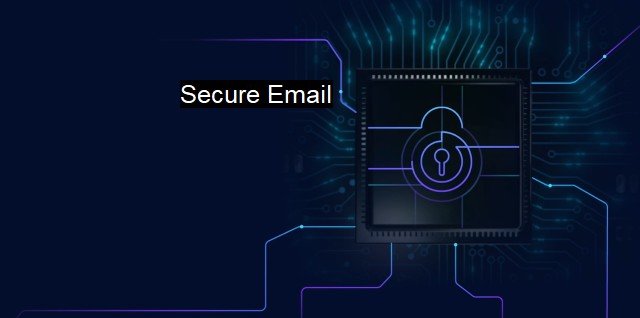What is Secure Email?
Secure Email: Enhancing Cybersecurity in the Evolution of Digital Communication
Secure Email is a specific depiction of email correspondence that applies protocols to secure the email content during transit and storage. The concept of Secure email is very important within the context of cybersecurity and antivirus as it encompasses technology, standards, and practices that enable the communication to remain private.Given the global digital surge, the act of sending and receiving emails has become a day-to-day task for most individuals and businesses. While it is a convenient and fast way of communication, it is equally open to numerous security threats. These security threats can range from simple annoying spam, email-borne viruses to sophisticated phishing attacks. Unsecured emails can serve as channels for malware, giving hackers unauthorized access to sensitive personal or business information. This shows why security measures are needed to protect email communications and why Secure Email is of relevance.
Secure Email often involves the use of industry standard encrypted protocols such as SSL/TLS or POP/IMAP to send or receive mail, rendering it inaccessible to anyone besides the intended recipient. It is important to note that encryption can be implemented at the server level or email client level for additional security layers. Encryption ensures that even if an email gets intercepted during transmission, its contents remain unintelligible to the unauthorized person viewing it. Secure email services commonly utilize techniques such as Public Key Infrastructure (PKI) for encryption to ensure that only authorized personnel with the correct decryption key can access the email content.
Secure email implies that the email service abides by specific standards for handling and safeguarding users' information. For instance, many secure email services follow guidelines for data protection, such as adhering to ISO/IEC 27001, a widely recognized international standard for managing information security. These services also commonly abide by privacy laws in regions such as the European Union's General Data Protection Regulation (GDPR).
Secure Email typically includes mechanisms for verifying the authenticity and integrity of emails. This can include using digital signatures to verify that the email content hasn't been tampered with during transit. Digital signature verifies the sender’s identity and ensures that the message was not altered in transit. This ensures that the recipients can trust the source of their email and its contents.
Apart from encryption and digital signatures, Secure Email protections also include spam filtering and antivirus scanning. Secure email services deploy multiple layers of automatic scanning to detect and quarantine emails that pose risk even before they reach the user's inbox. These security measures help in mitigating threats from viruses, spyware, ransomware, phishing attacks, and other forms of cyber threats that might otherwise compromise a user's system or data.
In the context of an organization, Secure Email may also involve additional measures such as Data Loss Prevention (DLP) policies to safeguard sensitive data. Some secure email services even offer features like secure email archiving for regulatory compliance, remote data wiping for lost devices, and automatic security updates to ensure that the users are safe from newly emerging threats.
Secure Email brings in a multi-faceted approach to protect email communications. An effective secure email system places user control and privacy at paramount importance. It safeguards not just the content of the communication but also the metadata related to it, ensuring full-scale protection. Given the ubiquitous nature of email and its crucial role in personal and business communications, the practice of secure email is central to an individual's and organization's cybersecurity. When implemented and utilized properly, Secure Email can greatly reduce the chances of falling victim to email-related cyber-attacks.

Secure Email FAQs
What is secure email?
Secure email is a form of email communication that uses encrypted methods to ensure that the content of the email is confidential and protected from unauthorized access. It provides a secure and safe alternative to traditional email communication and is an important measure for cybersecurity.Why is secure email important for cybersecurity?
Secure email is important for cybersecurity because it protects sensitive information from unauthorized access, interception, or theft. It ensures that the content of the email is confidential and cannot be accessed by hackers, identity thieves, or other cybercriminals. Secure email also helps prevent malware and virus attacks, which can compromise the security of an individual or organization's network.How does antivirus software help secure email?
Antivirus software helps secure email by detecting and blocking malware and viruses that can be transmitted through email. It scans incoming emails for suspicious attachments or links and prevents them from infecting your device or network. It also scans outgoing emails to ensure that they do not contain any malware that could compromise the security of the recipient's device or network.What are some best practices for secure email?
Some best practices for secure email include using strong passwords, avoiding clicking on links or downloading attachments from unknown or suspicious sources, encrypting sensitive data before sending it via email, and using antivirus software to scan for malware and viruses. It is also important to keep your software and systems up to date with the latest security patches and to be aware of phishing scams and social engineering tactics that cybercriminals may use to gain access to your sensitive information.| | A | | | B | | | C | | | D | | | E | | | F | | | G | | | H | | | I | | | J | | | K | | | L | | | M | |
| | N | | | O | | | P | | | Q | | | R | | | S | | | T | | | U | | | V | | | W | | | X | | | Y | | | Z | |
| | 1 | | | 2 | | | 3 | | | 4 | | | 7 | | | 8 | | |||||||